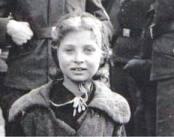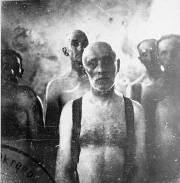MORE FREE TERM PAPERS
- RESEARCH PAPERS: - HISTORY -
|
|||||||||||||||||||
Extermination methods used during the Holocaust
The Holocaust is perhaps best remembered as a grotesque and gruesome
genocide that took place during the Second World War with a series of
events that lead to the inhumane disposal of anything but an Aryan race.
Frankly, what interests me the most about this pursuit of extinction is
the creativity involved for this mass elimination, and how this particular
exhibition changed the way we view and think of war today. There were
a variety of extermination methods used during the extent of the Holocaust
and the purpose of this paper is to enlighten the reader upon the various
techniques used by the Nazi party of Germany.
 The
first process in the systematic cycle was rounding up and herding the
Jewish community and putting them in confined quarters known as the ghettos,
where many died of starvation and dysentery. One may have heard about
the “Warsaw ghetto” as it was the most popular (Trunk). This
is where they were forced to wear the iconic yellow star letting others
know that they were Jewish. From there they were lined up (usually in
rows of five) and moved to the trains with the promise of work and sent
to the various concentration camps or extermination camps where death
was imminent upon their awaited arrival. For most Holocaust survivors
this piece would be remembered as "liquidation of the ghettos."
The
first process in the systematic cycle was rounding up and herding the
Jewish community and putting them in confined quarters known as the ghettos,
where many died of starvation and dysentery. One may have heard about
the “Warsaw ghetto” as it was the most popular (Trunk). This
is where they were forced to wear the iconic yellow star letting others
know that they were Jewish. From there they were lined up (usually in
rows of five) and moved to the trains with the promise of work and sent
to the various concentration camps or extermination camps where death
was imminent upon their awaited arrival. For most Holocaust survivors
this piece would be remembered as "liquidation of the ghettos."
Concentration camps and extermination camps differed in their purpose
on what they were doing with the non-Aryan race, such as Jews, gypsies
or even the handicapped. A concentration camp had the single purpose of
working the prisoners under inhumane conditions, with occasional killings
form the Nazi officers in charge. These conditions resulted in the death
of many Jewish families from over work, starvation and dysentery. The
extermination camps had the sole purpose of killing the prisoners in a
mass systematic approach; upon the death of the prisoners they would sent
to the crematorium to burn their bodies and make room for the arrival
of new inmates, creating a viscous cycle of death and arrival that kept
the death machine running for many years(The Killing Machine ).
While perhaps the extermination camps are the most memorable asset of
the Holocaust, the USHMM organization notes that there were six these
death factories; Chelmno
, Belzec, Sobibor, Treblinka, Auschwitz-Birkenau, and Majdanek where about
three million Jews were gassed (Deportations). The Extermination camps
or gas chambers were not the first method of purging European culture
from Jewish influences, but most memorable because they were the most
effective and the most systematic use for human disposal that civilization
has seen before or since. However these camps were one of the last implementations
set up and used by Nazi Germany. Most extermination camps used carbon
monoxide emanating from the internal combustion engines but there were
two that used something completely different. Auschwitz and Majdanek use
hydrogen cyanide from Zyklon B (Mazal) says one source. Zyklon B was used
as a pesticide to keep lice away from soldiers during the war but whenever
it was heated up, it would produce an extremely toxic gas.
One of the first methods used in the killing of Jews were the firing squads.
There was a group called the Einsatzruppen that would gather up a group
of Jews and march them out a couple of miles and force them to dig a grave(Vogelsang).
Whenever they were finished with this assigned task, the German soldiers
would line them up and shoot them in the back. This method was quickly
abandoned after seeing the stress and grief that was being applied to
the soldiers that were forced to triumph this treacherous task of shooting
innocent men and women in the back for no other reason than being Jewish.
 Gas
trucks were also implemented by the Einsatzruppen for the elimination
of anyone who did not fit into the will of the governing Nazi party (Vogelsang).
These gas trucks would pick up prisoners from some of the Jewish abiding
communities in Europe and drive for several miles with the captives in
the back being forced to breathe in the carbon monoxide that was the waste
product of the truck itself, causing them to suffer a slow, suffocating
death. Then, after all the prisoners were dead, they would drive to a
mass burial ground, and rid the vehicle of the recently deceased. This
method also affected the soldiers psychological profile greatly, having
to witness the murders directly.
Gas
trucks were also implemented by the Einsatzruppen for the elimination
of anyone who did not fit into the will of the governing Nazi party (Vogelsang).
These gas trucks would pick up prisoners from some of the Jewish abiding
communities in Europe and drive for several miles with the captives in
the back being forced to breathe in the carbon monoxide that was the waste
product of the truck itself, causing them to suffer a slow, suffocating
death. Then, after all the prisoners were dead, they would drive to a
mass burial ground, and rid the vehicle of the recently deceased. This
method also affected the soldiers psychological profile greatly, having
to witness the murders directly.
Experimentation and torture were not of uncommon would take them to freeze
(F, Isabelle). Most of the survivors of this nauseating nightmare remember
a man by the name of Dr. Mengele, or
the "angel of death," who would do experiments on the
younger populace of captives, primarily twins. While in the pursuit of
his research Dr. Mengele had murdered numerous children. Without leaving
a trail or any documentation on the experiments performed on these individuals,
sibling survivors had no hope of receiving the necessary medication to
rid their bodies of whatever substance that had been injected into their
childhood bodies. One account of this comes from Eva Bran Kor, (Forgiving
Dr. Menegle) who is one of the twins that survived the death grip of Dr.
Menegle. She wanted to find the documentation of the experiments that
was in fact being performed and help her sister to overcome the illness
that had been bestowed many years later. Unfortunately, with her valiant
efforts she found dead ends forcing her to come up "empty handed."
Seventy years after this dark disaster there are still many survivors
who are willing to give their testimony. These mind-boggling stories that
lets us view into the past to witness and see the taxing terrors that
sometimes might seem unimaginable, or incapable coming from a "civilized
culture."
The Holocaust has opened the door to the way we fight wars today. It has
also enlightened many individuals on the moral and ethical values of some
governing classes. Before world war two, chemical warfare had not yet
been introduced into the hands of these war institutions. Surprisingly
enough, this same creative idea a mere seventy years earlier had set off
our ethical alarm, causing us to be grief stricken, apologetic, and nauseated
at the thought of what had happened. We offered our condolences to those
who had survived and lost everything. Now chemical weapons are a prevalent
part of our war arsenal. The adaptation of our arsenal has forced us to
forget the devastating disaster that has taken millions of lives and broken
numerous families in the past. Government agencies offer this adaptation
in our arsenal for our own
protection, but we have forgotten what history has taught us about leaving
our own protection in the hands of the government.
Works Cited
F, Isabella. "Torture Methods Used during the Holocaust." Society. N.p., 2013. Web. 12 Apr.
2013.
WebsiteCommentsTagsEditDelete
"The Killing Machine." The Concentration Camps 1933-1945. N.p., 2009. Web. 12 Apr. 2013. WebsiteCommentsTagsEditDelete
Mazal, Harry W. "Methods of Murder." Holocaust History. N.p., 3 Jan. 2004. Web. 10 Apr.
2013.
WebsiteCommentsTagsEditDelete
Trunk, Isaiah. "Ghettos." Holocaust Encylopedia. Indiana University, 2006. Web. 12 Apr. 2013.


